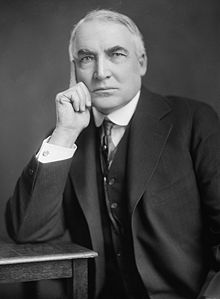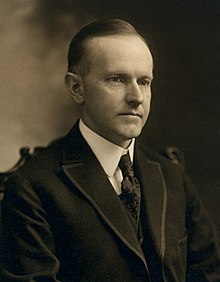from 1920 - 1930, age 21-31
- 1920 Census, Alden Twp, McHenry Illinois
- 1921, Warren G. Harding President
- 1923, Calvin Coolidge President
- 1924, death of father Joseph Ware Tapp
- 1925, Tri State Tornado
- 1929, Herbert Hoover President
- 1930 Census, New Trier, Cook Illinois
- Historical Insight -- Ship Building on the Great Lakes
1920 Census, age 21
living with family on a rented farm at Alden Township, McHenry County Illinois |
| 1920 Census, Alden, McHenry Illinois |
Line 76 starts the Tapp Family Farm in Alden Township, McHenry County Illinois
- Grace E. Tapp, age 20, attending school, able to read and write. born in Illinois. no occupation, living with her family.
I wonder what school she attended at the age of 20? It was unusual for girls to continue school for that long, I think.
 |
| Warren G. Harding from Wikipedia |
1921, age 22
Warren Gamaliel Harding, 29th President
 |
| Calvin Coolidge from Wikipedia |
1923, age 24
Calvin Coolidge, 30th President
1924, age 25
Death of father, Joseph Ware Tapp, 21 September 1924, Elgin, Kane County, Illinois1925, age 26
Historical Insight -- Tri-State Tornado |
| Herbert Hoover from Wikipedia |
1929, age 30
Herbert Clark Hoover, 31st President
1930 Census, age 31
living at 455 Washington Avenue, New Trier, Cook, Illinois.
 |
| Grace Tapp, 1930 Census |
This area is today known as Glencoe. Then it was the Village of Glencoe, New Trier Township, Cook County Illinois. We find her on line 88, living as a servant with the Carson Family at 455 Washington Avenue.
- She is a white female, age 30, single, did not attend school, is able to read and write. She and her parents were born in Illinois. The State code is 61 -- I'll have to research what this means. She speaks English, works as a nursemaid for this private family. The office code in the next column is 9596, which I'll have to research as well. She was a worker, and does not seem to have been unemployed.
- The family, Samuel and Camille Carsen have three children, two boys ages 11 and 10, then daughter Margaret age 4 0/12. It must be Margeret that Grace was taking care of. The Mr. was an Executive of a Dry Goods something. It looks like there were a lot of families with servants in this neighborhood.
The house as it looks today:
 |
| Grace Tapp, 1930 Census, standard view Google Maps |
 |
| Grace Tapp, 455 Washington Avenue New Trier, Cook, Illinois Google Maps Satellite View |
 |
| Grace Tapp, 455 Washington Avenue New Trier, Cook, Illinois Google Street View |
This is the description of the house, according to Zillow:
455 Washington Ave, Glencoe, IL is a single family home that contains 3,872 sq ft and was built in 1915. It contains 6 bedrooms and 4.5 bathrooms.Because it was built in 1915, it must have looked pretty much the same today as it did in Grace's time of living there in 1930.
Historical Insight -- Shipbuilding on the Great Lakes
1930s, Historical Insight -- The Great Depression
from Ancestry.com |
| Credit: Wikimedia Commons/Public Domain |
The workers who built ships in Great Lakes ports from the 1890s to the 1950s were highly skilled laborers. The production of large steel-hulled ships required the talents of steel workers, blacksmiths, carpenters, painters, and engineers. The American Steel Barge Company of West Superior, Wisconsin, had one of the largest dry docks on the lakes in the 1890s. Employing up to 1,500 workers, the company could have 12 ships in production at the same time. The Chicago Shipbuilding Company produced the first steel-hulled ship on Lake Michigan in 1890 and became a world leader by 1899. The Great Lakes shipbuilding industry was vital to the success of the Midwestern economy throughout the early 20th century. World War II submarines were produced in Manitowoc, Wisconsin, and by the 1950s, the American Ship Building Company in Cleveland, Ohio, had the largest shipyard in the region.
Media Gallery

Opened in 1959, the St. Lawrence Seaway aided the Canadian industry, but the U.S. shipbuilding industry on the lakes was stagnating.

By the 1960s, the age of the steam freighter had given way to new diesel-powered ships that were cheaper to build.
No comments:
Post a Comment